Analysis of Nestle's Business Environment, Functions, and SWOT
VerifiedAdded on 2020/06/05
|15
|3685
|45
Report
AI Summary
This report provides a comprehensive analysis of Nestle's business environment. It begins with an introduction to the business environment and its impact on organizational functions. The report then delves into the differences between various organizational functions within Nestle, highlighting their linkages with organizational objectives and structure. A significant portion of the report is dedicated to examining the positive and negative impacts of the macro-environment on Nestle's business operations, utilizing PESTLE analysis. Furthermore, a detailed SWOT analysis of Nestle is presented, evaluating its strengths, weaknesses, opportunities, and threats. The analysis explores the strategic positioning of the company, its cultural values, and its commitment to corporate social responsibility. Finally, the report concludes with a summary of key findings and insights into Nestle's business performance.

THE BUSINESS
ENVIRONMENT
ENVIRONMENT
Paraphrase This Document
Need a fresh take? Get an instant paraphrase of this document with our AI Paraphraser

Table of Contents
INTRODUCTION...........................................................................................................................1
TASK 2............................................................................................................................................1
P3: Difference between different organizational functions and their linkage with objectives
and structure...........................................................................................................................1
TASK 3 ..........................................................................................................................................4
P4: The positive and negative impact of macro environment on Nestle business operations4
TASK 4............................................................................................................................................7
P5: SWOT analysis of Nestle ................................................................................................7
P6 Strength and weakness of the Nestle.................................................................................9
CONCLUSION .............................................................................................................................10
REFERENCES..............................................................................................................................11
INTRODUCTION...........................................................................................................................1
TASK 2............................................................................................................................................1
P3: Difference between different organizational functions and their linkage with objectives
and structure...........................................................................................................................1
TASK 3 ..........................................................................................................................................4
P4: The positive and negative impact of macro environment on Nestle business operations4
TASK 4............................................................................................................................................7
P5: SWOT analysis of Nestle ................................................................................................7
P6 Strength and weakness of the Nestle.................................................................................9
CONCLUSION .............................................................................................................................10
REFERENCES..............................................................................................................................11

⊘ This is a preview!⊘
Do you want full access?
Subscribe today to unlock all pages.

Trusted by 1+ million students worldwide
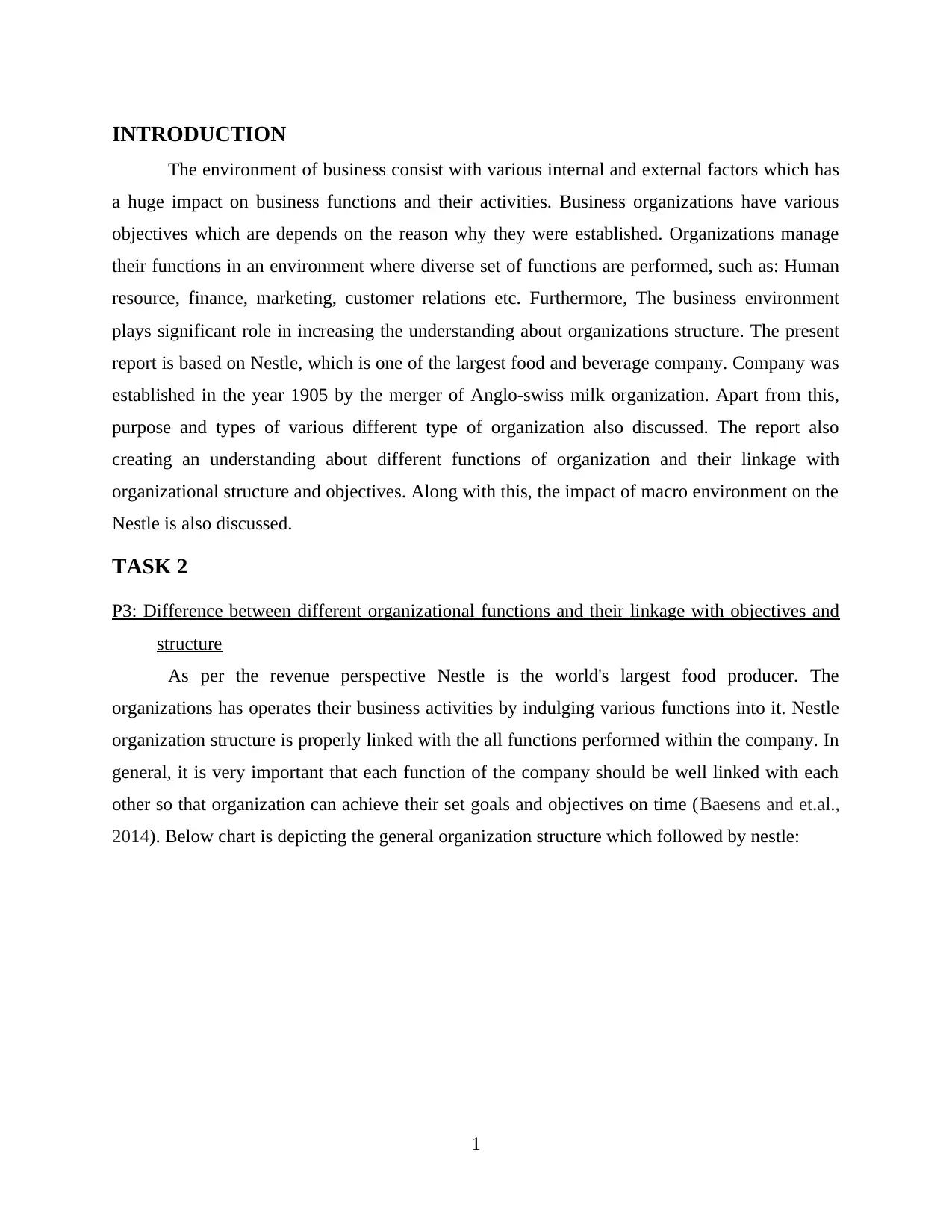
INTRODUCTION
The environment of business consist with various internal and external factors which has
a huge impact on business functions and their activities. Business organizations have various
objectives which are depends on the reason why they were established. Organizations manage
their functions in an environment where diverse set of functions are performed, such as: Human
resource, finance, marketing, customer relations etc. Furthermore, The business environment
plays significant role in increasing the understanding about organizations structure. The present
report is based on Nestle, which is one of the largest food and beverage company. Company was
established in the year 1905 by the merger of Anglo-swiss milk organization. Apart from this,
purpose and types of various different type of organization also discussed. The report also
creating an understanding about different functions of organization and their linkage with
organizational structure and objectives. Along with this, the impact of macro environment on the
Nestle is also discussed.
TASK 2
P3: Difference between different organizational functions and their linkage with objectives and
structure
As per the revenue perspective Nestle is the world's largest food producer. The
organizations has operates their business activities by indulging various functions into it. Nestle
organization structure is properly linked with the all functions performed within the company. In
general, it is very important that each function of the company should be well linked with each
other so that organization can achieve their set goals and objectives on time (Baesens and et.al.,
2014). Below chart is depicting the general organization structure which followed by nestle:
1
The environment of business consist with various internal and external factors which has
a huge impact on business functions and their activities. Business organizations have various
objectives which are depends on the reason why they were established. Organizations manage
their functions in an environment where diverse set of functions are performed, such as: Human
resource, finance, marketing, customer relations etc. Furthermore, The business environment
plays significant role in increasing the understanding about organizations structure. The present
report is based on Nestle, which is one of the largest food and beverage company. Company was
established in the year 1905 by the merger of Anglo-swiss milk organization. Apart from this,
purpose and types of various different type of organization also discussed. The report also
creating an understanding about different functions of organization and their linkage with
organizational structure and objectives. Along with this, the impact of macro environment on the
Nestle is also discussed.
TASK 2
P3: Difference between different organizational functions and their linkage with objectives and
structure
As per the revenue perspective Nestle is the world's largest food producer. The
organizations has operates their business activities by indulging various functions into it. Nestle
organization structure is properly linked with the all functions performed within the company. In
general, it is very important that each function of the company should be well linked with each
other so that organization can achieve their set goals and objectives on time (Baesens and et.al.,
2014). Below chart is depicting the general organization structure which followed by nestle:
1
Paraphrase This Document
Need a fresh take? Get an instant paraphrase of this document with our AI Paraphraser

As per the structure of Nestle organization chart it is divided into three different parts,
which is enumerated below:
Top level management- The top level management contains governor, board of directors,
Chief executive officer and officer related to different department such as finance, information
centre, operations, marketing, Human resources etc. The top level management plays significant
role in organizational functions as they introduced the policies to the enterprise and set
objectives align with it. In Nestle making strategic policies and plans for the initiatives done by
top level management (Bagautdinova and et.al., 2014).
Middle level management- At the middle level of Nestle's organizational structure
branch and departmental managers are placed. They are responsible and answerable to top level
management for the operations in their respective department (Belás and et.al., 2014).
Lower level management- This level is considered as supervisory and operative level of
management. In Nestle this level contains supervisors, officers etc. They play very important role
in assigning the jobs and tasks to workers for their day to day activities. They are the one who
bear most of the responsibilities for product quality and quantity of production (Botha, Kourie
and Snyman, 2014).
2
which is enumerated below:
Top level management- The top level management contains governor, board of directors,
Chief executive officer and officer related to different department such as finance, information
centre, operations, marketing, Human resources etc. The top level management plays significant
role in organizational functions as they introduced the policies to the enterprise and set
objectives align with it. In Nestle making strategic policies and plans for the initiatives done by
top level management (Bagautdinova and et.al., 2014).
Middle level management- At the middle level of Nestle's organizational structure
branch and departmental managers are placed. They are responsible and answerable to top level
management for the operations in their respective department (Belás and et.al., 2014).
Lower level management- This level is considered as supervisory and operative level of
management. In Nestle this level contains supervisors, officers etc. They play very important role
in assigning the jobs and tasks to workers for their day to day activities. They are the one who
bear most of the responsibilities for product quality and quantity of production (Botha, Kourie
and Snyman, 2014).
2
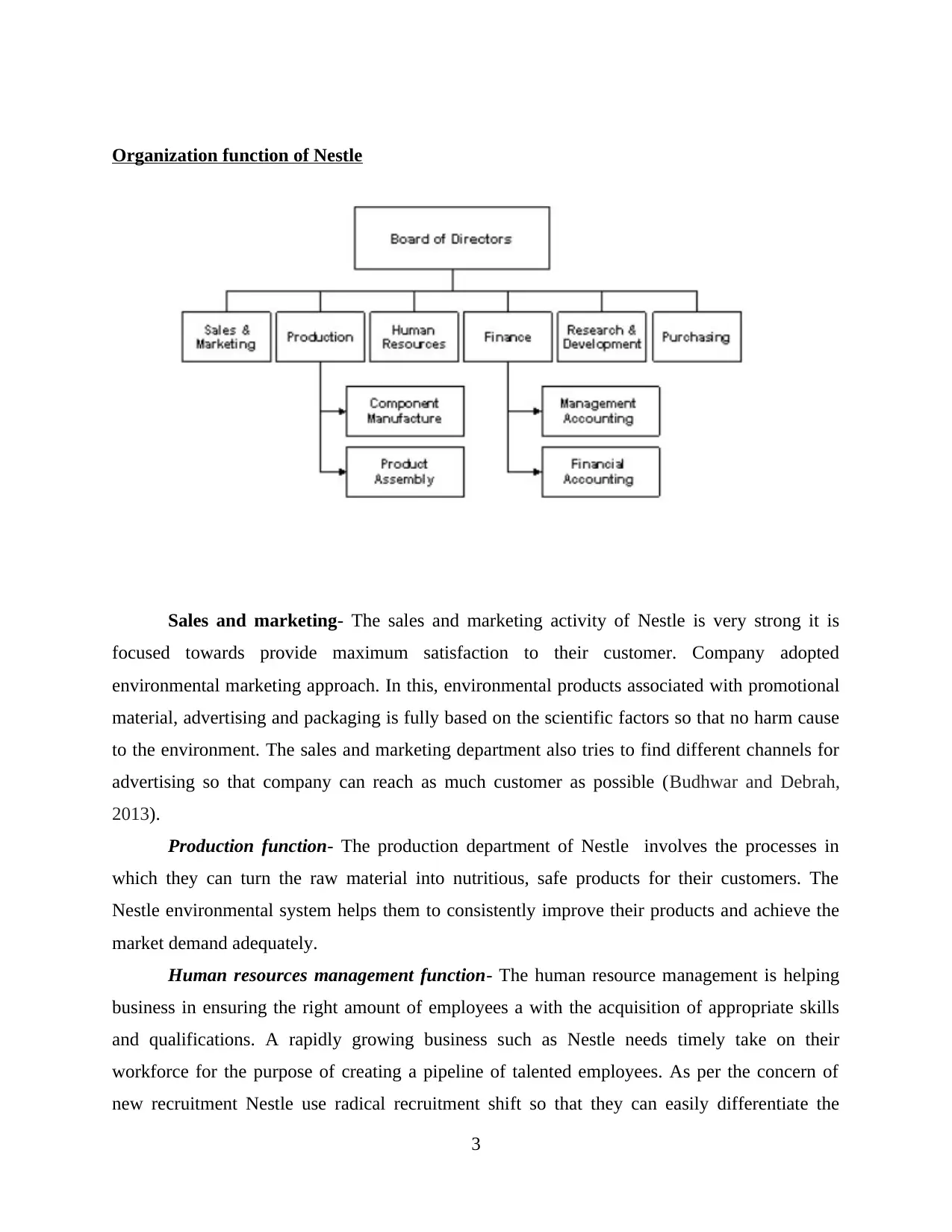
Organization function of Nestle
Sales and marketing- The sales and marketing activity of Nestle is very strong it is
focused towards provide maximum satisfaction to their customer. Company adopted
environmental marketing approach. In this, environmental products associated with promotional
material, advertising and packaging is fully based on the scientific factors so that no harm cause
to the environment. The sales and marketing department also tries to find different channels for
advertising so that company can reach as much customer as possible (Budhwar and Debrah,
2013).
Production function- The production department of Nestle involves the processes in
which they can turn the raw material into nutritious, safe products for their customers. The
Nestle environmental system helps them to consistently improve their products and achieve the
market demand adequately.
Human resources management function- The human resource management is helping
business in ensuring the right amount of employees a with the acquisition of appropriate skills
and qualifications. A rapidly growing business such as Nestle needs timely take on their
workforce for the purpose of creating a pipeline of talented employees. As per the concern of
new recruitment Nestle use radical recruitment shift so that they can easily differentiate the
3
Sales and marketing- The sales and marketing activity of Nestle is very strong it is
focused towards provide maximum satisfaction to their customer. Company adopted
environmental marketing approach. In this, environmental products associated with promotional
material, advertising and packaging is fully based on the scientific factors so that no harm cause
to the environment. The sales and marketing department also tries to find different channels for
advertising so that company can reach as much customer as possible (Budhwar and Debrah,
2013).
Production function- The production department of Nestle involves the processes in
which they can turn the raw material into nutritious, safe products for their customers. The
Nestle environmental system helps them to consistently improve their products and achieve the
market demand adequately.
Human resources management function- The human resource management is helping
business in ensuring the right amount of employees a with the acquisition of appropriate skills
and qualifications. A rapidly growing business such as Nestle needs timely take on their
workforce for the purpose of creating a pipeline of talented employees. As per the concern of
new recruitment Nestle use radical recruitment shift so that they can easily differentiate the
3
⊘ This is a preview!⊘
Do you want full access?
Subscribe today to unlock all pages.

Trusted by 1+ million students worldwide
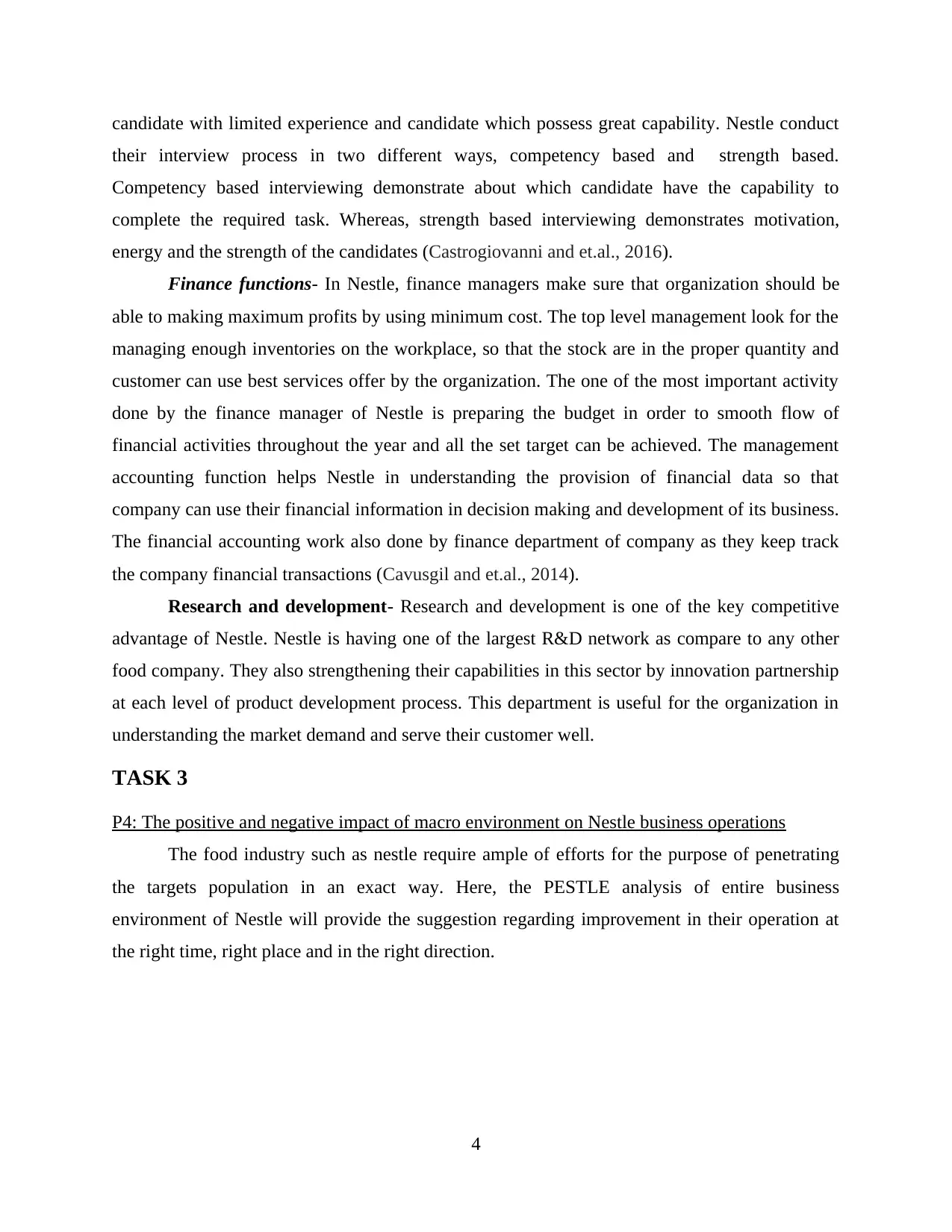
candidate with limited experience and candidate which possess great capability. Nestle conduct
their interview process in two different ways, competency based and strength based.
Competency based interviewing demonstrate about which candidate have the capability to
complete the required task. Whereas, strength based interviewing demonstrates motivation,
energy and the strength of the candidates (Castrogiovanni and et.al., 2016).
Finance functions- In Nestle, finance managers make sure that organization should be
able to making maximum profits by using minimum cost. The top level management look for the
managing enough inventories on the workplace, so that the stock are in the proper quantity and
customer can use best services offer by the organization. The one of the most important activity
done by the finance manager of Nestle is preparing the budget in order to smooth flow of
financial activities throughout the year and all the set target can be achieved. The management
accounting function helps Nestle in understanding the provision of financial data so that
company can use their financial information in decision making and development of its business.
The financial accounting work also done by finance department of company as they keep track
the company financial transactions (Cavusgil and et.al., 2014).
Research and development- Research and development is one of the key competitive
advantage of Nestle. Nestle is having one of the largest R&D network as compare to any other
food company. They also strengthening their capabilities in this sector by innovation partnership
at each level of product development process. This department is useful for the organization in
understanding the market demand and serve their customer well.
TASK 3
P4: The positive and negative impact of macro environment on Nestle business operations
The food industry such as nestle require ample of efforts for the purpose of penetrating
the targets population in an exact way. Here, the PESTLE analysis of entire business
environment of Nestle will provide the suggestion regarding improvement in their operation at
the right time, right place and in the right direction.
4
their interview process in two different ways, competency based and strength based.
Competency based interviewing demonstrate about which candidate have the capability to
complete the required task. Whereas, strength based interviewing demonstrates motivation,
energy and the strength of the candidates (Castrogiovanni and et.al., 2016).
Finance functions- In Nestle, finance managers make sure that organization should be
able to making maximum profits by using minimum cost. The top level management look for the
managing enough inventories on the workplace, so that the stock are in the proper quantity and
customer can use best services offer by the organization. The one of the most important activity
done by the finance manager of Nestle is preparing the budget in order to smooth flow of
financial activities throughout the year and all the set target can be achieved. The management
accounting function helps Nestle in understanding the provision of financial data so that
company can use their financial information in decision making and development of its business.
The financial accounting work also done by finance department of company as they keep track
the company financial transactions (Cavusgil and et.al., 2014).
Research and development- Research and development is one of the key competitive
advantage of Nestle. Nestle is having one of the largest R&D network as compare to any other
food company. They also strengthening their capabilities in this sector by innovation partnership
at each level of product development process. This department is useful for the organization in
understanding the market demand and serve their customer well.
TASK 3
P4: The positive and negative impact of macro environment on Nestle business operations
The food industry such as nestle require ample of efforts for the purpose of penetrating
the targets population in an exact way. Here, the PESTLE analysis of entire business
environment of Nestle will provide the suggestion regarding improvement in their operation at
the right time, right place and in the right direction.
4
Paraphrase This Document
Need a fresh take? Get an instant paraphrase of this document with our AI Paraphraser

Political factors- Nestle need to be very careful about the political factors because they
are operating their business activities in several countries. The rules regulations and policies set
by the government are differ as per the country. Here, Nestle has to look upon their political
dynamics such as Import-export, excise duties, taxation so that they can smoothly enter into their
target segment and developed hygienic products which allowed by the government bodies.
Apart from the positive side, Nestle can face various risk because of the political factors. The
policies are uncertain at the global level so it is very difficult to cop-up with different regulation
of different countries. As a part of food industry Nestle requires to maintain the health policies
and quality of products. Failure in this will lead to miserable consequences for Nestle (Dragoi
and et.al., 2013).
Economic factors- According to the countries the economic standards also changes.
Economy of country differs everywhere. Here, Nestle need to follow different economic policies
as per the target segment. The economic factors such as- inflation rates, interest rate, economic
growth and recession which have both positive as well as negative impact on Nestle. The price of
the products is also set as per the economic condition of target company. For making the
5
Illustration 1: PESTEL
(Source:PESTEL ANALYSIS, 2017)
are operating their business activities in several countries. The rules regulations and policies set
by the government are differ as per the country. Here, Nestle has to look upon their political
dynamics such as Import-export, excise duties, taxation so that they can smoothly enter into their
target segment and developed hygienic products which allowed by the government bodies.
Apart from the positive side, Nestle can face various risk because of the political factors. The
policies are uncertain at the global level so it is very difficult to cop-up with different regulation
of different countries. As a part of food industry Nestle requires to maintain the health policies
and quality of products. Failure in this will lead to miserable consequences for Nestle (Dragoi
and et.al., 2013).
Economic factors- According to the countries the economic standards also changes.
Economy of country differs everywhere. Here, Nestle need to follow different economic policies
as per the target segment. The economic factors such as- inflation rates, interest rate, economic
growth and recession which have both positive as well as negative impact on Nestle. The price of
the products is also set as per the economic condition of target company. For making the
5
Illustration 1: PESTEL
(Source:PESTEL ANALYSIS, 2017)
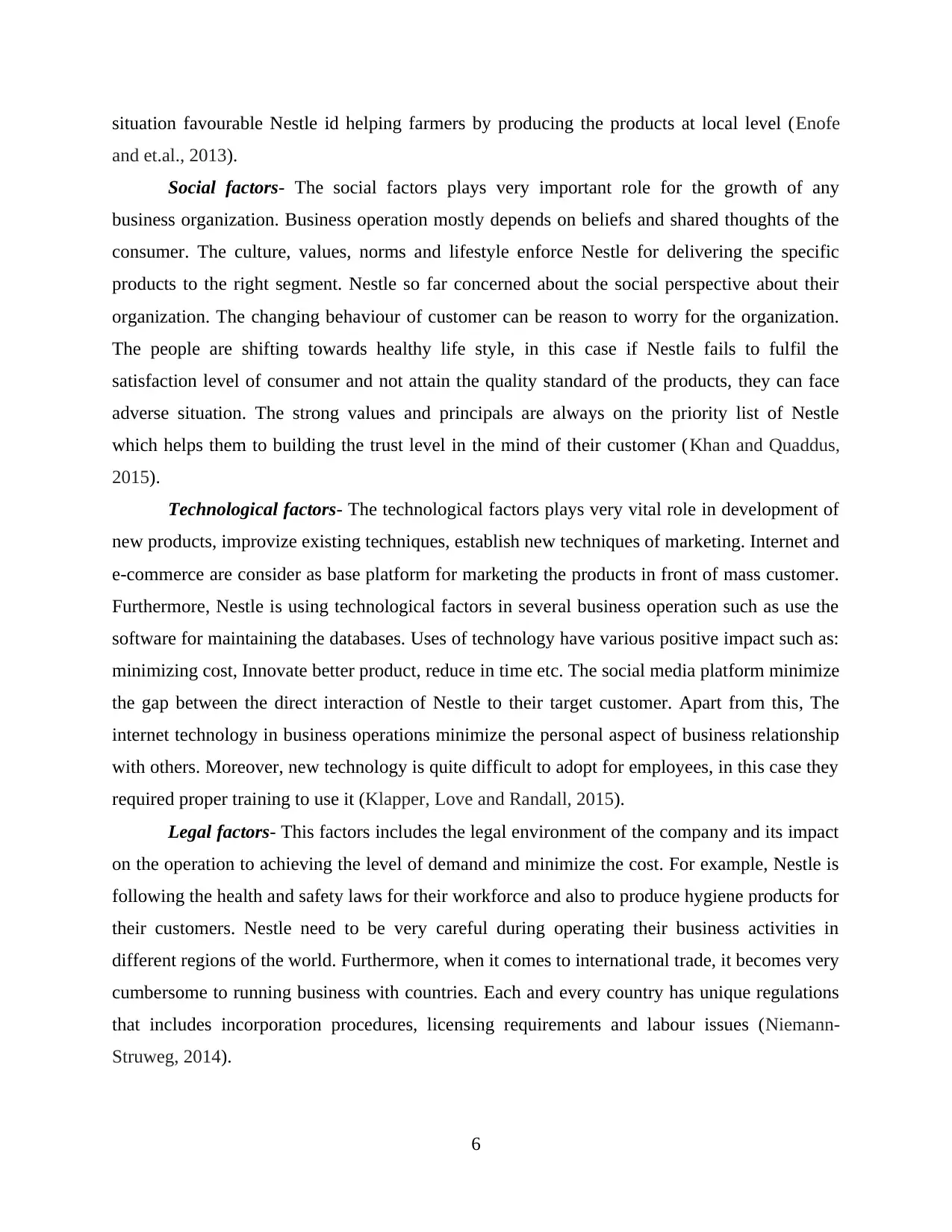
situation favourable Nestle id helping farmers by producing the products at local level (Enofe
and et.al., 2013).
Social factors- The social factors plays very important role for the growth of any
business organization. Business operation mostly depends on beliefs and shared thoughts of the
consumer. The culture, values, norms and lifestyle enforce Nestle for delivering the specific
products to the right segment. Nestle so far concerned about the social perspective about their
organization. The changing behaviour of customer can be reason to worry for the organization.
The people are shifting towards healthy life style, in this case if Nestle fails to fulfil the
satisfaction level of consumer and not attain the quality standard of the products, they can face
adverse situation. The strong values and principals are always on the priority list of Nestle
which helps them to building the trust level in the mind of their customer (Khan and Quaddus,
2015).
Technological factors- The technological factors plays very vital role in development of
new products, improvize existing techniques, establish new techniques of marketing. Internet and
e-commerce are consider as base platform for marketing the products in front of mass customer.
Furthermore, Nestle is using technological factors in several business operation such as use the
software for maintaining the databases. Uses of technology have various positive impact such as:
minimizing cost, Innovate better product, reduce in time etc. The social media platform minimize
the gap between the direct interaction of Nestle to their target customer. Apart from this, The
internet technology in business operations minimize the personal aspect of business relationship
with others. Moreover, new technology is quite difficult to adopt for employees, in this case they
required proper training to use it (Klapper, Love and Randall, 2015).
Legal factors- This factors includes the legal environment of the company and its impact
on the operation to achieving the level of demand and minimize the cost. For example, Nestle is
following the health and safety laws for their workforce and also to produce hygiene products for
their customers. Nestle need to be very careful during operating their business activities in
different regions of the world. Furthermore, when it comes to international trade, it becomes very
cumbersome to running business with countries. Each and every country has unique regulations
that includes incorporation procedures, licensing requirements and labour issues (Niemann-
Struweg, 2014).
6
and et.al., 2013).
Social factors- The social factors plays very important role for the growth of any
business organization. Business operation mostly depends on beliefs and shared thoughts of the
consumer. The culture, values, norms and lifestyle enforce Nestle for delivering the specific
products to the right segment. Nestle so far concerned about the social perspective about their
organization. The changing behaviour of customer can be reason to worry for the organization.
The people are shifting towards healthy life style, in this case if Nestle fails to fulfil the
satisfaction level of consumer and not attain the quality standard of the products, they can face
adverse situation. The strong values and principals are always on the priority list of Nestle
which helps them to building the trust level in the mind of their customer (Khan and Quaddus,
2015).
Technological factors- The technological factors plays very vital role in development of
new products, improvize existing techniques, establish new techniques of marketing. Internet and
e-commerce are consider as base platform for marketing the products in front of mass customer.
Furthermore, Nestle is using technological factors in several business operation such as use the
software for maintaining the databases. Uses of technology have various positive impact such as:
minimizing cost, Innovate better product, reduce in time etc. The social media platform minimize
the gap between the direct interaction of Nestle to their target customer. Apart from this, The
internet technology in business operations minimize the personal aspect of business relationship
with others. Moreover, new technology is quite difficult to adopt for employees, in this case they
required proper training to use it (Klapper, Love and Randall, 2015).
Legal factors- This factors includes the legal environment of the company and its impact
on the operation to achieving the level of demand and minimize the cost. For example, Nestle is
following the health and safety laws for their workforce and also to produce hygiene products for
their customers. Nestle need to be very careful during operating their business activities in
different regions of the world. Furthermore, when it comes to international trade, it becomes very
cumbersome to running business with countries. Each and every country has unique regulations
that includes incorporation procedures, licensing requirements and labour issues (Niemann-
Struweg, 2014).
6
⊘ This is a preview!⊘
Do you want full access?
Subscribe today to unlock all pages.

Trusted by 1+ million students worldwide
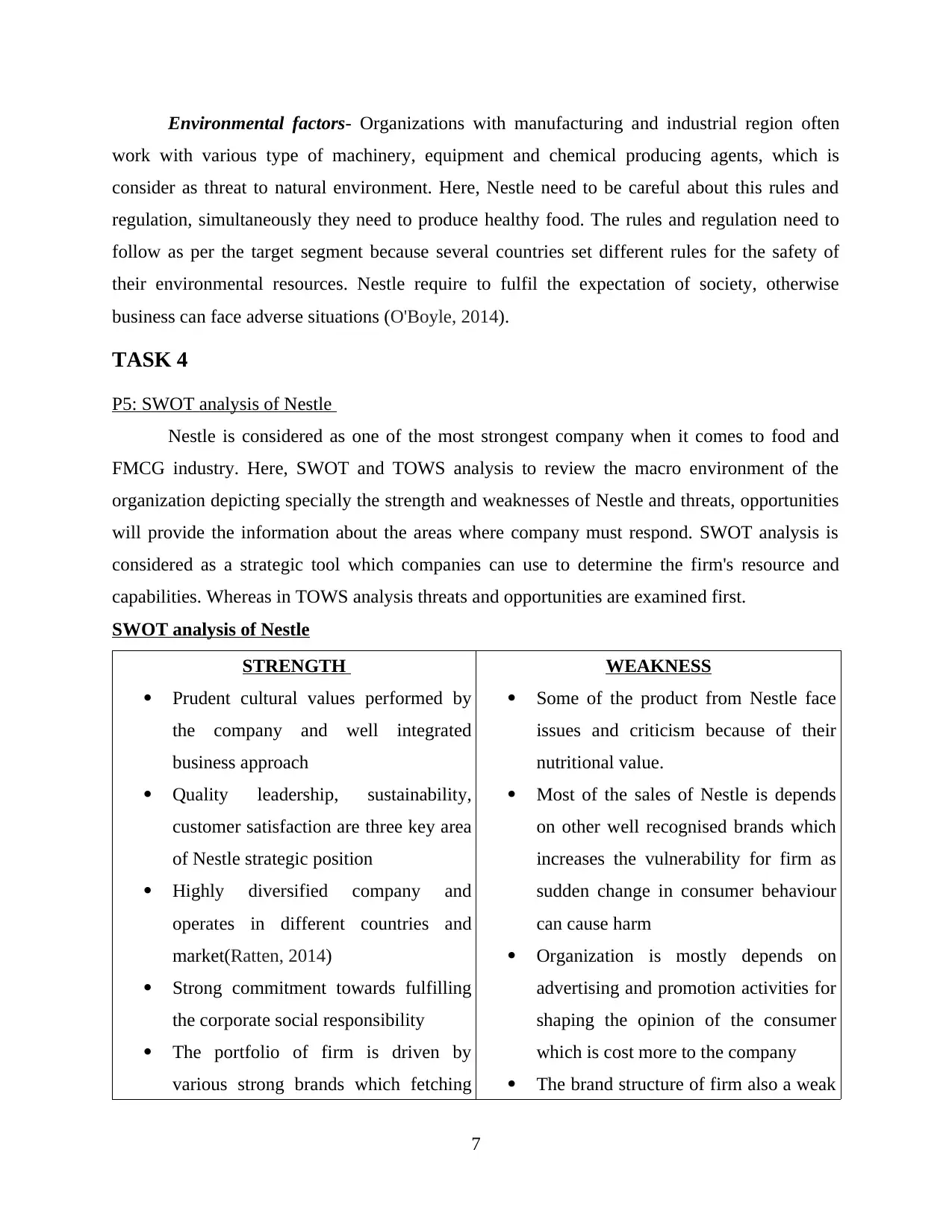
Environmental factors- Organizations with manufacturing and industrial region often
work with various type of machinery, equipment and chemical producing agents, which is
consider as threat to natural environment. Here, Nestle need to be careful about this rules and
regulation, simultaneously they need to produce healthy food. The rules and regulation need to
follow as per the target segment because several countries set different rules for the safety of
their environmental resources. Nestle require to fulfil the expectation of society, otherwise
business can face adverse situations (O'Boyle, 2014).
TASK 4
P5: SWOT analysis of Nestle
Nestle is considered as one of the most strongest company when it comes to food and
FMCG industry. Here, SWOT and TOWS analysis to review the macro environment of the
organization depicting specially the strength and weaknesses of Nestle and threats, opportunities
will provide the information about the areas where company must respond. SWOT analysis is
considered as a strategic tool which companies can use to determine the firm's resource and
capabilities. Whereas in TOWS analysis threats and opportunities are examined first.
SWOT analysis of Nestle
STRENGTH
Prudent cultural values performed by
the company and well integrated
business approach
Quality leadership, sustainability,
customer satisfaction are three key area
of Nestle strategic position
Highly diversified company and
operates in different countries and
market(Ratten, 2014)
Strong commitment towards fulfilling
the corporate social responsibility
The portfolio of firm is driven by
various strong brands which fetching
WEAKNESS
Some of the product from Nestle face
issues and criticism because of their
nutritional value.
Most of the sales of Nestle is depends
on other well recognised brands which
increases the vulnerability for firm as
sudden change in consumer behaviour
can cause harm
Organization is mostly depends on
advertising and promotion activities for
shaping the opinion of the consumer
which is cost more to the company
The brand structure of firm also a weak
7
work with various type of machinery, equipment and chemical producing agents, which is
consider as threat to natural environment. Here, Nestle need to be careful about this rules and
regulation, simultaneously they need to produce healthy food. The rules and regulation need to
follow as per the target segment because several countries set different rules for the safety of
their environmental resources. Nestle require to fulfil the expectation of society, otherwise
business can face adverse situations (O'Boyle, 2014).
TASK 4
P5: SWOT analysis of Nestle
Nestle is considered as one of the most strongest company when it comes to food and
FMCG industry. Here, SWOT and TOWS analysis to review the macro environment of the
organization depicting specially the strength and weaknesses of Nestle and threats, opportunities
will provide the information about the areas where company must respond. SWOT analysis is
considered as a strategic tool which companies can use to determine the firm's resource and
capabilities. Whereas in TOWS analysis threats and opportunities are examined first.
SWOT analysis of Nestle
STRENGTH
Prudent cultural values performed by
the company and well integrated
business approach
Quality leadership, sustainability,
customer satisfaction are three key area
of Nestle strategic position
Highly diversified company and
operates in different countries and
market(Ratten, 2014)
Strong commitment towards fulfilling
the corporate social responsibility
The portfolio of firm is driven by
various strong brands which fetching
WEAKNESS
Some of the product from Nestle face
issues and criticism because of their
nutritional value.
Most of the sales of Nestle is depends
on other well recognised brands which
increases the vulnerability for firm as
sudden change in consumer behaviour
can cause harm
Organization is mostly depends on
advertising and promotion activities for
shaping the opinion of the consumer
which is cost more to the company
The brand structure of firm also a weak
7
Paraphrase This Document
Need a fresh take? Get an instant paraphrase of this document with our AI Paraphraser

the global recognition
Appropriate and proper teamwork
within the organization which promotes
higher level of job satisfaction and
employee commitment
point as there are various products
under the same umbrella group so it is
difficult to manage
OPPORTUNITY
Nestle have capability and resources to
reaching new consumer markets, they
can work in emerging economies
There is wide opportunity to invest in
BRICS economies as they are in
growth stage
Online retail business is growing
rapidly which is directly opening up
new distribution channels
The disposable income of people is
increasing due to political initiatives,
improve literacy rate and managed
inflation.
Strategic alliance with other major
companies opening doors of
opportunities for Nestle.
THREAT
The industry catering to the food sector
where the higher power is in the hand
of consumer
The prices of the raw material are not
stagnant which influence ability of
company to produce at same price
Increasing dynamic factors in the
external macro environment are
increasing the level of competition
The change in technological factors are
influencing the firm to innovate, which
is increasing challenges
TOWS analysis of Nestle
WT strategy- This is one of the most defensive strategy which Nestle can adopt.
Company can manage higher standard in their production process so that conflict associated with
nutritional values can be resolve.
WO strategy- This strategies are attempts to reduce the weakness and maximize the
opportunities. Nestle can expand their business activities in growing countries, where they can
use promotional tools so that more number of people can be aware about the products and
services which they are offering (Savrul, Incekara and Sener, 2014).
8
Appropriate and proper teamwork
within the organization which promotes
higher level of job satisfaction and
employee commitment
point as there are various products
under the same umbrella group so it is
difficult to manage
OPPORTUNITY
Nestle have capability and resources to
reaching new consumer markets, they
can work in emerging economies
There is wide opportunity to invest in
BRICS economies as they are in
growth stage
Online retail business is growing
rapidly which is directly opening up
new distribution channels
The disposable income of people is
increasing due to political initiatives,
improve literacy rate and managed
inflation.
Strategic alliance with other major
companies opening doors of
opportunities for Nestle.
THREAT
The industry catering to the food sector
where the higher power is in the hand
of consumer
The prices of the raw material are not
stagnant which influence ability of
company to produce at same price
Increasing dynamic factors in the
external macro environment are
increasing the level of competition
The change in technological factors are
influencing the firm to innovate, which
is increasing challenges
TOWS analysis of Nestle
WT strategy- This is one of the most defensive strategy which Nestle can adopt.
Company can manage higher standard in their production process so that conflict associated with
nutritional values can be resolve.
WO strategy- This strategies are attempts to reduce the weakness and maximize the
opportunities. Nestle can expand their business activities in growing countries, where they can
use promotional tools so that more number of people can be aware about the products and
services which they are offering (Savrul, Incekara and Sener, 2014).
8
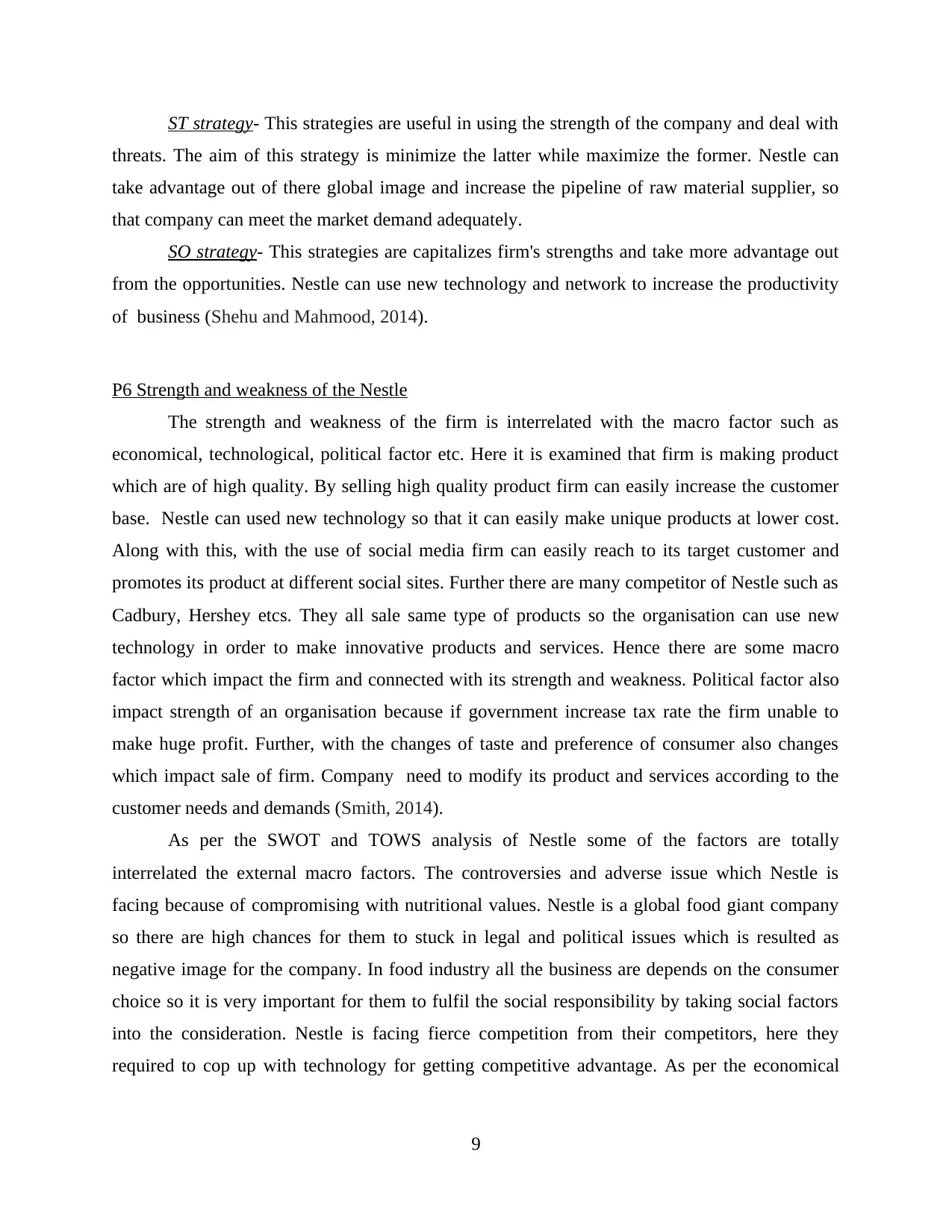
ST strategy- This strategies are useful in using the strength of the company and deal with
threats. The aim of this strategy is minimize the latter while maximize the former. Nestle can
take advantage out of there global image and increase the pipeline of raw material supplier, so
that company can meet the market demand adequately.
SO strategy- This strategies are capitalizes firm's strengths and take more advantage out
from the opportunities. Nestle can use new technology and network to increase the productivity
of business (Shehu and Mahmood, 2014).
P6 Strength and weakness of the Nestle
The strength and weakness of the firm is interrelated with the macro factor such as
economical, technological, political factor etc. Here it is examined that firm is making product
which are of high quality. By selling high quality product firm can easily increase the customer
base. Nestle can used new technology so that it can easily make unique products at lower cost.
Along with this, with the use of social media firm can easily reach to its target customer and
promotes its product at different social sites. Further there are many competitor of Nestle such as
Cadbury, Hershey etcs. They all sale same type of products so the organisation can use new
technology in order to make innovative products and services. Hence there are some macro
factor which impact the firm and connected with its strength and weakness. Political factor also
impact strength of an organisation because if government increase tax rate the firm unable to
make huge profit. Further, with the changes of taste and preference of consumer also changes
which impact sale of firm. Company need to modify its product and services according to the
customer needs and demands (Smith, 2014).
As per the SWOT and TOWS analysis of Nestle some of the factors are totally
interrelated the external macro factors. The controversies and adverse issue which Nestle is
facing because of compromising with nutritional values. Nestle is a global food giant company
so there are high chances for them to stuck in legal and political issues which is resulted as
negative image for the company. In food industry all the business are depends on the consumer
choice so it is very important for them to fulfil the social responsibility by taking social factors
into the consideration. Nestle is facing fierce competition from their competitors, here they
required to cop up with technology for getting competitive advantage. As per the economical
9
threats. The aim of this strategy is minimize the latter while maximize the former. Nestle can
take advantage out of there global image and increase the pipeline of raw material supplier, so
that company can meet the market demand adequately.
SO strategy- This strategies are capitalizes firm's strengths and take more advantage out
from the opportunities. Nestle can use new technology and network to increase the productivity
of business (Shehu and Mahmood, 2014).
P6 Strength and weakness of the Nestle
The strength and weakness of the firm is interrelated with the macro factor such as
economical, technological, political factor etc. Here it is examined that firm is making product
which are of high quality. By selling high quality product firm can easily increase the customer
base. Nestle can used new technology so that it can easily make unique products at lower cost.
Along with this, with the use of social media firm can easily reach to its target customer and
promotes its product at different social sites. Further there are many competitor of Nestle such as
Cadbury, Hershey etcs. They all sale same type of products so the organisation can use new
technology in order to make innovative products and services. Hence there are some macro
factor which impact the firm and connected with its strength and weakness. Political factor also
impact strength of an organisation because if government increase tax rate the firm unable to
make huge profit. Further, with the changes of taste and preference of consumer also changes
which impact sale of firm. Company need to modify its product and services according to the
customer needs and demands (Smith, 2014).
As per the SWOT and TOWS analysis of Nestle some of the factors are totally
interrelated the external macro factors. The controversies and adverse issue which Nestle is
facing because of compromising with nutritional values. Nestle is a global food giant company
so there are high chances for them to stuck in legal and political issues which is resulted as
negative image for the company. In food industry all the business are depends on the consumer
choice so it is very important for them to fulfil the social responsibility by taking social factors
into the consideration. Nestle is facing fierce competition from their competitors, here they
required to cop up with technology for getting competitive advantage. As per the economical
9
⊘ This is a preview!⊘
Do you want full access?
Subscribe today to unlock all pages.

Trusted by 1+ million students worldwide
1 out of 15
Related Documents
Your All-in-One AI-Powered Toolkit for Academic Success.
+13062052269
info@desklib.com
Available 24*7 on WhatsApp / Email
![[object Object]](/_next/static/media/star-bottom.7253800d.svg)
Unlock your academic potential
Copyright © 2020–2025 A2Z Services. All Rights Reserved. Developed and managed by ZUCOL.





